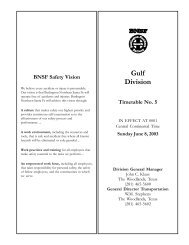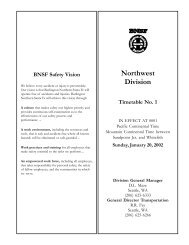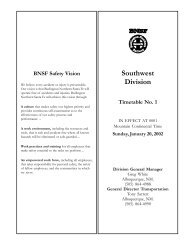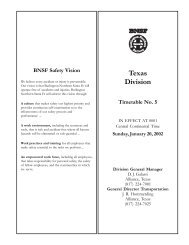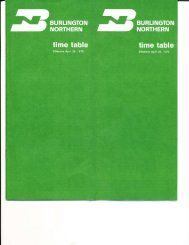2 11/5/03 - Friends of the Burlington Northern Railroad
2 11/5/03 - Friends of the Burlington Northern Railroad
2 11/5/03 - Friends of the Burlington Northern Railroad
You also want an ePaper? Increase the reach of your titles
YUMPU automatically turns print PDFs into web optimized ePapers that Google loves.
NORTHWEST DIVISION—No. 2—November 5, 20<strong>03</strong>—San Poil Subdivision<br />
51<br />
<strong>of</strong>ficial business cars, shall be marshalled in and moved<br />
at <strong>the</strong> rear <strong>of</strong> freight trains immediately ahead <strong>of</strong> <strong>the</strong><br />
operating caboose.<br />
2. Where track configurations require extreme care in set<strong>of</strong>f<br />
movements, such occupied service equipment may be<br />
moved at <strong>the</strong> head end <strong>of</strong> freight trains behind <strong>the</strong><br />
locomotive units, but for no greater distance than twenty<br />
miles, and at no greater speed than twenty miles per hour.<br />
In Canada—Tank cars containing Flammable Compressed<br />
Gases must be separated in a train from tank car shipments <strong>of</strong><br />
Chlorine, Anhydrous Ammonia and Sulphur Dioxide by at least<br />
five (5) cars. All o<strong>the</strong>r US restrictions apply.<br />
If train length is not sufficient to properly position placarded<br />
cars, <strong>the</strong>y must be held for a later train that has sufficient cars<br />
to accommodate <strong>the</strong> cars as prescribed within <strong>the</strong> regulations.<br />
When necessary, <strong>the</strong> breaking <strong>of</strong> train blocks to comply with<br />
proper placement is authorized.<br />
Trains operating within <strong>the</strong> Canadian Province handling<br />
hazardous material will make a visual inspection <strong>of</strong> such cars<br />
at intervals <strong>of</strong> no greater than twenty (20) miles.<br />
Following Locations Exceed 1% Grade<br />
MILEPOST<br />
PERCENT OF GRADE<br />
MP 1.1 to MP 4.5 1.8% Descending<br />
MP 5.6 to MP 6.3 1.06% Descending<br />
MP 7.0 to MP 7.4 1.5% Ascending<br />
MP 8.0 to MP 8.3 1.5% Descending<br />
MP 8.5 to MP 9.0 1.2% Descending<br />
MP 10.6 to MP 10.8 1.06% Descending<br />
MP <strong>11</strong>.0 to MP <strong>11</strong>.5 1.06% Ascending<br />
MP 60.0 to MP 69.0 1.0% Descending<br />
Mountain Grade Instructions—When controlling train speed,<br />
limit <strong>the</strong> effective brake pipe reduction to 18 psi or less. If <strong>the</strong><br />
train cannot be controlled with an effective brake pipe<br />
reduction <strong>of</strong> 18 psi or less, stop immediately and secure train.<br />
Initiate an emergency brake application no later than 5 MPH<br />
above <strong>the</strong> maximum authorized speed whenever problems<br />
controlling speed occur.<br />
In <strong>the</strong> event <strong>of</strong> a train separation, <strong>the</strong> following apply:<br />
1. Apply hand brakes to 75% <strong>of</strong> all cars not coupled to a<br />
locomotive consist.<br />
2. If <strong>the</strong> locomotive brakes will not hold <strong>the</strong> train, and it is<br />
necessary to recharge <strong>the</strong> air brake system, set <strong>the</strong><br />
required number <strong>of</strong> hand brakes or retainers to hold <strong>the</strong><br />
train before attempting to release and recharge <strong>the</strong> air<br />
brake system.<br />
3. As necessary, make repairs or set out bad order<br />
equipment. Do not attempt to recouple <strong>the</strong> train if <strong>the</strong><br />
trailing tonnage exceeds <strong>the</strong> locomotives’ tonnage<br />
rating.<br />
4. After recoupling <strong>the</strong> train, release and recharge <strong>the</strong> air<br />
brake system. Do not release any handbrakes or<br />
retainers at this time.<br />
5. After recharging <strong>the</strong> air brake system, make a service<br />
application to hold <strong>the</strong> train on <strong>the</strong> grade before<br />
releasing <strong>the</strong> handbrakes or retainers which had been<br />
applied.<br />
Flash Flood Warnings—Refer to Item 33 in <strong>the</strong> System<br />
Special Instructions. The following locations have been<br />
identified as “critical areas” and are limited to restricted speed:<br />
MP 57.4 to MP 75.6<br />
CUSTOMS CLEARANCE—Entering and leaving US/Canadian<br />
borders, Train crews are required to have two (2) forms <strong>of</strong> ID<br />
to cross border. One (1) must be a photo ID.<br />
Laurier/Cascade border—Westbound: Train must stop at MP<br />
34.4 at US customs until crew member clears train at US/<br />
Canadian customs.<br />
Eastbound: Train must stop at MP 34.4 at Canada customs<br />
until crew member clears train at Canadian/US customs<br />
Danville/Carson border—Westbound: Crews will call via<br />
radio, Canadian customs, Carson, for permission to depart<br />
Canada prior to passing MP 48.7, <strong>the</strong>n crew will call US<br />
customs, Danville for permission to enter US prior to passing<br />
MP 48.7.<br />
Eastbound: Crews will call via radio, US customs, Danville, for<br />
permission to depart US prior to passing MP 48.9, <strong>the</strong>n crew<br />
will call Canadian customs, Carson, for permission to enter<br />
Canada prior to passing MP 48.9.<br />
All borders—<br />
1. When BNSF railbound equipment (hirail, etc.) arrives at<br />
<strong>the</strong> Canadian Border (Carson/Danville), <strong>the</strong>y will radio <strong>the</strong><br />
border and advise <strong>the</strong> Canadian side.<br />
2. Customs will make a determination if <strong>the</strong>y want to<br />
inspect <strong>the</strong> railbound equipment and advise <strong>the</strong> BNSF RR<br />
immediately.<br />
3. In <strong>the</strong> event an inspection is required, Customs will<br />
issue instructions to <strong>the</strong> BNSF RR crew.<br />
4. In <strong>the</strong> event no inspection is required, Customs will give<br />
a verbal clearance.<br />
This procedure will apply for all inward and outward<br />
movements.<br />
Grand Forks, B.C.—Transport Canada requires all train<br />
movements over Carson Road Crossing on <strong>the</strong> Wye Tracks<br />
shall be flagged by a member <strong>of</strong> <strong>the</strong> crew. Do not occupy<br />
Carson Spur between BNSF Main Track and GFRR Main<br />
Track between 0700 and 1000 Hours.<br />
High cap box cars will not be shoved under <strong>the</strong> hood at<br />
Pacific Abrasives, track 430.<br />
8. Line Segments<br />
Road Line Segments<br />
Line Segments Limits<br />
377 ........... Kettle Falls to Laurier, WA<br />
392 ........... Laurier to Danville, WA<br />
377 ........... Kettle Falls to Laurier, WA<br />
9. Locations Not Shown as Stations<br />
Name<br />
62208<br />
Brauner Lbr. Co.<br />
Spur<br />
622<strong>11</strong><br />
Portland Cement<br />
Spur<br />
62219<br />
Orient<br />
Lumber<br />
62228<br />
Goldstake<br />
62235<br />
Cascade<br />
Miles - Location<br />
3.0 west <strong>of</strong><br />
West Kettle Falls<br />
5.9 west <strong>of</strong><br />
West Kettle Falls<br />
Capacity<br />
Cars<br />
Switch<br />
Opens<br />
4 West<br />
6 East<br />
2.0<br />
west <strong>of</strong> Barstow<br />
19<br />
Both<br />
6.1<br />
east <strong>of</strong> Laurier<br />
13<br />
East<br />
0.3<br />
west <strong>of</strong> Laurier<br />
14<br />
Both




